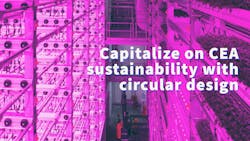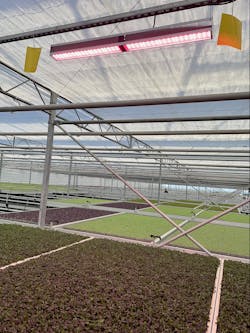Indoor farming has been championed as a viable solution for the global food and climate crisis. The vital role of LED grow lighting in controlled environment agriculture (CEA) offers growers several benefits, including a reduction in long-term operational and capital expenditures, improved energy efficiency, and an extended operating life. However, the industry also needs to focus on engineering horticultural products for greater sustainability and circularity, urges Simon Deacon, the founder and CEO of Light Sciences Technology (LST), my current employer.
The circular economy and the benefits
According to the Circularity Gap Report 2022 by the Amsterdam-based organization Circle Economy, the circular economy accounts for 8.6% of the world economy. In 2018, this number was 9.1%.
While the circular economy isn’t a new concept, it offers a solution that addresses issues of increasing concern, such as climate change, landfill waste, and resource extraction and scarcity. A circular economy can also reduce energy use and expenses, freeing up capital to access new markets and helping to ensure a steady, continuous supply chain for industries and companies. By recovering resources via recycling, composting, or remanufacturing, organizations can pump value back into their bottom line.
In the big picture, supporting the circular economy means optimizing resources and reducing the overall global consumption of raw materials.
Industry developments in circularity lighting
Across the LED lighting industry, manufacturers and researchers are exploring materials innovations to push LED solutions beyond energy efficiency to prioritize the circular economy in product design. One innovation is the 3D printing of luminaires from recyclable polycarbonate. They are typically not painted and have fewer parts and screws. The carbon footprint of a 3D-printed luminaire — including materials, production, and logistics — is between 50% and 75% lower than its conventional equivalent. One manufacturer has launched a LED panel that uses around 94% less plastic, by weight, than its standard counterpart. To extend the panel’s life, the modules containing the light engines and drivers can be replaced without any wiring or tools. Old modules can be returned to the company for recycling into new modules.
In September 2021, lighting manufacturers in Europe gained resources to adopt standards and legislation related to the circular economy, based on the Waste from Electrical and Electronic Equipment (WEEE) Directive EC2002/94. In the U.K., Recolight, a WEEE compliance scheme for the lighting industry, aggregated services to help the lighting industry embrace the circular economy. Among its services are training workshops to help lighting producers design for circularity and to navigate emerging voluntary and mandatory specifications. It is also promoting awareness of the CIBSE TM66 standard, “Creating a circular economy in the lighting industry,” which certifies a manufacturer’s level of compliance.
For more CEA insights, see our preview of the Resilient Harvests Conference and register to attend the November 2022 event at resilientharvestsconference.com.
Indoor farming
Applying a business model that values sustainability and the circular economy can benefit the CEA industry and value chain. Indoor farming, which includes greenhouses, vertical farming, and polytunnels, addresses the need for a more sustainable food system, but its products should support sustainability as well. Recent advances in LED grow lights now enable the recycling and reuse of their materials, a major step forward in green innovation.
Typically, LED grow lights are replaced every five years and discarded in landfills. To solve this issue, LST set about developing a modular lighting solution. NurturGrow’s integrated design and separation technologies allow for an exchange of components. With 44 variants — a combination of low-, medium-, and high-powered linear toplights and interlights — the luminaire’s modular design allows growers to install the optimal μmol/J for their plants, space, and energy requirements. NurturGrow’s interchangeable inner body lets growers update, change, or reconfigure their lights as needed without requiring the replacement of the unit infrastructure or body.
A recently added slimline version accommodates closed, climate-controlled growing facilities in multilayer growth applications, such as a vertical/city farm, container, or research center. Its lower profile and custom length provide optimal growing space and an efficacy of up to 2.8 μmol.
NurturGrow’s lighting solutions consist of four component parts: an internal core, an LED and driver printed circuit board, an external case, and an injection-molded endcap. All four parts are recyclable; customers can return them to LST for recycling into new products at their end of life.
During the products’ operating life, 85% of each fixture is reusable by growers. Preparing the fixtures for their next application can be facilitated on-site, allowing their upgrade with minimal downtime. Only the driver and LED PCBs would be upgraded to ensure the use of the latest energy-efficient technologies. Made for reuse up to 25 years, NurturGrow can reduce landfill waste by more than 100 tons, as compared with other LED grow lighting brands using nonrecyclable products, according to internal LST research.
The fixture’s design and patented PCB architecture allow for the integration of SensorGrow, LST’s all-in-one growing-intelligence tool that lets growers adjust light outputs to optimize plant growth through use of captured data. It measures key air-zone and root-zone parameters in defined zones, reducing the use of additional resources such as energy, water, and nutrients to help optimize crop yields.
A sustainable business investment
Balancing opex and capex costs in indoor farms with an eye toward the long term is critical. Lighting can make up to 30% of the initial setup cost of a vertical farm and more than 25% when the farm is operational. LED light fixtures provide better light quality using less energy, saving up to a third on future costs. A vertical farm has an approximately seven-year ROI so reducing infrastructure costs is crucial.
Investing in LED grow light technology bespoke to each grower’s crops and space does not always mean more expensive. It also has the potential to offer growers greater ROI by allowing them to grow more for less.
Growing more with less
AgTech isn’t focused merely on producing higher crop yields and using less land and energy. To practice true sustainability, the industry should review its product and material portfolios. Lighting is but one aspect of indoor farming; AgTech innovators need to consider how this product category, along with others in horticulture, can minimize the sector’s carbon footprint and support a circular economy.
CRAIG PRICE is operations director at Light Science Technologies (LST), a horticultural lighting and sensor solutions developer based in Derbyshire in England. Price has worked in landscape architecture and lighting technology manufacturing operations for more than 20 years. At LST, Price oversees project management, supply chain development, operational expenses, client negotiations, estimated project expenses, and more with an eye toward improving business operations and CEA client experience for scalable farming.
Light Science Technologies provides CEA solutions such as those described in this article.
For up-to-the-minute LED and SSL updates, follow us on Twitter. You’ll find curated content and commentary, as well as information on industry events, webcasts, and surveys on our LinkedIn page and our Facebook page.







